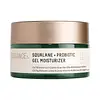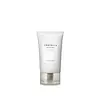What's inside
What's inside
 Key Ingredients
Key Ingredients

 Benefits
Benefits

 Concerns
Concerns

 Ingredients Side-by-side
Ingredients Side-by-side

Water
Skin ConditioningGlycerin
HumectantSqualane
EmollientLepidium Sativum Sprout Extract
Skin ConditioningSodium Acrylates Copolymer
Caprylic/Capric Triglyceride
MaskingBisabolol
MaskingPhospholipids
Skin ConditioningHansenula/Kloeckera/Lactobacillus/Lactococcus/Leuconostoc/Pediococcus/Saccharomyces/Fig/Lemon Ferment
Skin ConditioningSodium Hyaluronate
HumectantChondrus Crispus Extract
Skin ConditioningAllantoin
Skin ConditioningGlycine Soja Sterols
EmollientLinoleic Acid
CleansingCapryloyl Glycerin/Sebacic Acid Copolymer
Skin ConditioningDiheptyl Succinate
EmollientCellulose Gum
Emulsion StabilisingLecithin
EmollientSorbitan Oleate
EmulsifyingIsoeicosane
EmollientChitosan
Sodium Phytate
Caprylyl Glycol
EmollientPhenoxyethanol
Preservative1,2-Hexanediol
Skin ConditioningCitric Acid
BufferingWater, Glycerin, Squalane, Lepidium Sativum Sprout Extract, Sodium Acrylates Copolymer, Caprylic/Capric Triglyceride, Bisabolol, Phospholipids, Hansenula/Kloeckera/Lactobacillus/Lactococcus/Leuconostoc/Pediococcus/Saccharomyces/Fig/Lemon Ferment, Sodium Hyaluronate, Chondrus Crispus Extract, Allantoin, Glycine Soja Sterols, Linoleic Acid, Capryloyl Glycerin/Sebacic Acid Copolymer, Diheptyl Succinate, Cellulose Gum, Lecithin, Sorbitan Oleate, Isoeicosane, Chitosan, Sodium Phytate, Caprylyl Glycol, Phenoxyethanol, 1,2-Hexanediol, Citric Acid
Water
Skin ConditioningGlycerin
HumectantPropanediol
SolventDipropylene Glycol
HumectantCyclopentasiloxane
EmollientCentella Asiatica Extract
Cleansing1,2-Hexanediol
Skin ConditioningCyclohexasiloxane
EmollientTrehalose
HumectantCaprylyl Methicone
Skin ConditioningC12-14 Pareth-12
EmulsifyingCarbomer
Emulsion StabilisingTromethamine
BufferingC30-45 Alkyl Cetearyl Dimethicone Crosspolymer
EmollientAmmonium Acryloyldimethyltaurate/Vp Copolymer
Butylene Glycol
HumectantXanthan Gum
EmulsifyingZingiber Officinale Root Extract
MaskingMentha Piperita Leaf Extract
Skin ConditioningEthylhexylglycerin
Skin ConditioningDipotassium Glycyrrhizate
HumectantTranexamic Acid
AstringentDextrin
AbsorbentTheobroma Cacao Seed Extract
AntioxidantLeuconostoc/Radish Root Ferment Filtrate
AntimicrobialBiosaccharide Gum-1
HumectantDisodium EDTA
Sodium Hyaluronate
HumectantBeta-Glucan
Skin ConditioningHydrogenated Lecithin
EmulsifyingCoptis Chinensis Root Extract
AntioxidantCetearyl Alcohol
EmollientStearic Acid
CleansingCeramide NP
Skin ConditioningCeramide Ng
Skin ConditioningCholesterol
EmollientPhytosphingosine
Skin ConditioningCeramide As
Skin ConditioningCeramide AP
Skin ConditioningCeramide EOP
Skin ConditioningWater, Glycerin, Propanediol, Dipropylene Glycol, Cyclopentasiloxane, Centella Asiatica Extract, 1,2-Hexanediol, Cyclohexasiloxane, Trehalose, Caprylyl Methicone, C12-14 Pareth-12, Carbomer, Tromethamine, C30-45 Alkyl Cetearyl Dimethicone Crosspolymer, Ammonium Acryloyldimethyltaurate/Vp Copolymer, Butylene Glycol, Xanthan Gum, Zingiber Officinale Root Extract, Mentha Piperita Leaf Extract, Ethylhexylglycerin, Dipotassium Glycyrrhizate, Tranexamic Acid, Dextrin, Theobroma Cacao Seed Extract, Leuconostoc/Radish Root Ferment Filtrate, Biosaccharide Gum-1, Disodium EDTA, Sodium Hyaluronate, Beta-Glucan, Hydrogenated Lecithin, Coptis Chinensis Root Extract, Cetearyl Alcohol, Stearic Acid, Ceramide NP, Ceramide Ng, Cholesterol, Phytosphingosine, Ceramide As, Ceramide AP, Ceramide EOP
 Reviews
Reviews

Ingredients Explained
These ingredients are found in both products.
Ingredients higher up in an ingredient list are typically present in a larger amount.
1,2-Hexanediol is a synthetic liquid and another multi-functional powerhouse.
It is a:
- Humectant, drawing moisture into the skin
- Emollient, helping to soften skin
- Solvent, dispersing and stabilizing formulas
- Preservative booster, enhancing the antimicrobial activity of other preservatives
Glycerin is already naturally found in your skin. It helps moisturize and protect your skin.
A study from 2016 found glycerin to be more effective as a humectant than AHAs and hyaluronic acid.
As a humectant, it helps the skin stay hydrated by pulling moisture to your skin. The low molecular weight of glycerin allows it to pull moisture into the deeper layers of your skin.
Hydrated skin improves your skin barrier; Your skin barrier helps protect against irritants and bacteria.
Glycerin has also been found to have antimicrobial and antiviral properties. Due to these properties, glycerin is often used in wound and burn treatments.
In cosmetics, glycerin is usually derived from plants such as soybean or palm. However, it can also be sourced from animals, such as tallow or animal fat.
This ingredient is organic, colorless, odorless, and non-toxic.
Glycerin is the name for this ingredient in American English. British English uses Glycerol/Glycerine.
Learn more about GlycerinSodium Hyaluronate is hyaluronic acid's salt form. It is commonly derived from the sodium salt of hyaluronic acid.
Like hyaluronic acid, it is great at holding water and acts as a humectant. This makes it a great skin hydrating ingredient.
Sodium Hyaluronate is naturally occurring in our bodies and is mostly found in eye fluid and joints.
These are some other common types of Hyaluronic Acid:
Learn more about Sodium HyaluronateWater. It's the most common cosmetic ingredient of all. You'll usually see it at the top of ingredient lists, meaning that it makes up the largest part of the product.
So why is it so popular? Water most often acts as a solvent - this means that it helps dissolve other ingredients into the formulation.
You'll also recognize water as that liquid we all need to stay alive. If you see this, drink a glass of water. Stay hydrated!
Learn more about Water